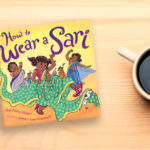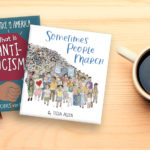A recent article in Publishers Weekly titled “Comics Formats Go Younger” highlights just one of the reasons that educators and librarians are building collections of graphic novels to target new readers. The piece summarizes Karen MacPherson, children’s and teen services coordinator at the Takoma Park (Maryland) Library, as she notes that the format’s “interdependence between text and art makes graphic novels particularly appropriate for early readers.”
Here, author and illustrator Stephen Shaskan talks with Lisa Bullard about his own enthusiasm for the graphic novel’s kid-friendly format and its ability to enhance subjects across the curriculum.
Pizza and Taco: Best Party Ever! —the second title in your graphic novel series for younger readers—came out at the end of January, and Pizza and Taco: Super-Awesome Comic! comes out August 10th. It’s clear your series is well received by early readers and the educators who work with them. What draws you as a creator to the graphic novel format?
As a child, I was considered a reluctant reader, but I somehow managed to read thousands of comics. Each month, I saved my allowance and my dad drove me to the comic book shop. I loved reading the stories and taking in all the awesome artwork. I drew my own comic characters, including Super Grandpa!
When I illustrated the Q & Ray series (written by my wife Trisha Speed Shaskan), the first graphic novels I ever worked on, I felt giddy because I love to draw comics, but also because I remembered and felt the joy that comics brought me as a child. I officially got to create comic characters, panel out pages, and help tell a story visually, using all that I learned from being an avid reader of comic books. Drawing graphic novels made me want to write my own, and the result was Pizza and Taco: Who’s the Best? The series gives me so much joy; I laugh constantly while creating it.
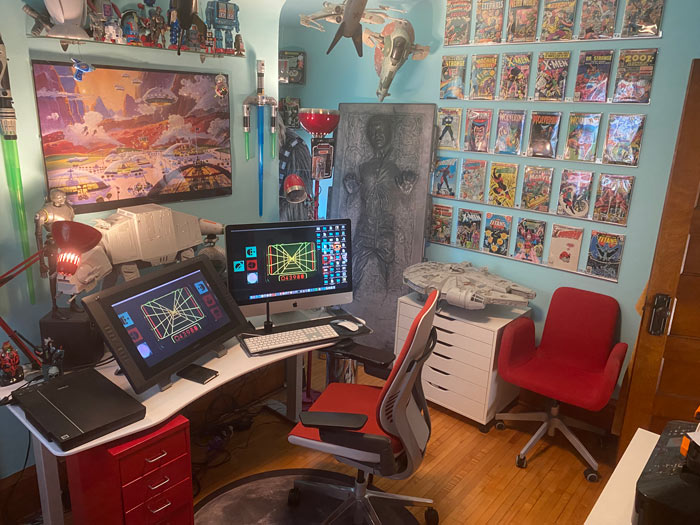
How do you find yourself growing as a creator as you continue to craft new titles in the same series?
With every new book, I try to add a new setting, and sometimes I add new characters to expand the world. For each book, the characters grow in different ways. I’ve had the opportunity to really get to know Pizza and Taco. When I started working on the third book (which would become Pizza and Taco: Super-Awesome Comic!), I didn’t have a set theme for the book, and I didn’t quite know which direction to go. I sketched the main characters having a conversation about what they’d like to do next, and they strongly agreed I should make a book about creating comics.
Do young readers respond to graphic novels in a special way?
Trisha and I have visited many schools since the Q and Ray series came out. We focus our second-grade through fifth-grade presentations on creating graphic novels. With our help, the kids create a graphic novel character as a group, like Pimple the bunny, who plays soccer and is afraid of carrots. It’s amazing to see how quickly a group of students can generate ideas. And their imaginations are always so refreshing.
There is something about the combination of words and images paneled out on the pages of a graphic novel that says to kids it was made for them. At many schools, we’ve had students at the end of our presentations share their own graphic novels. Many times, there are two students who worked on a single comic together.
There is something about the combination of words and images paneled out on the pages of a graphic novel that says to kids it was made for them.”
Does the graphic novel format help students connect with reading in a new way?
I feel the graphic novel format has always connected kids with reading; it’s not new. What’s new is that educators and parents are starting to widely accept graphic novels as literature and as a way to get kids excited about reading. I’ve had several parents reach out to me through social media to let me know their young readers and reluctant readers love Pizza and Taco.
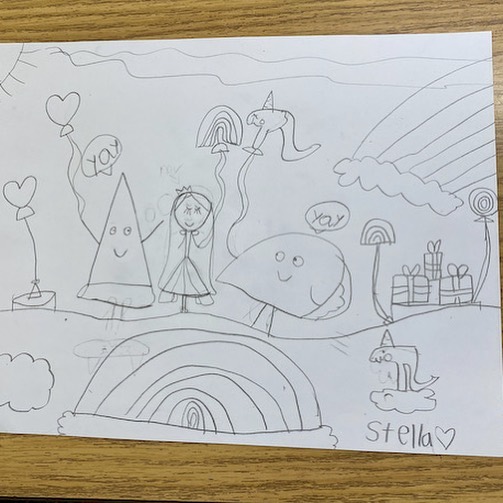
Do graphic novels have something to offer educators who are focusing on subjects other than reading?
There’s a graphic novel for every subject: graphic adaptations of novels, nonfiction, memoirs and biographies, action/adventure, and humor. In our Q and Ray series, Trisha wrote about art in The Case of the Missing Mola Lisa (it’s “Mola” because all the characters are forest critters), science in Meteorite or Meteor-Wrong?, and sports in Foul Play at Elm Tree Park. Pizza and Taco: Who’s the Best? incorporates debates and voting. Pizza and Taco: Super-Awesome Comic! models how to work together.
There’s a graphic novel for every subject.”
How have your experiences as an educator shaped your creative work?
For seven years, I taught after-school art classes at an elementary school. For twelve years, I taught preschool. I use what I’ve learned as an educator in all my books. Kids are at the center of all my stories and art. Max Speed is about how children play out their fears in pretend play. Toad on the Road: A Cautionary Tale is a book with a lot of repetition, loud noises, print awareness, and call-and-response that engages emerging readers. I created The Three Triceratops Tuff after watching three preschool students play The Three Billy Goats Gruff as dinosaurs. The idea for Pizza and Taco came from school visits: When Trisha and I created a group character with students and asked what the character’s favorite food was, the students’ answer was always pizza or tacos. I thought a slice of pizza and a taco would make a great duo.
You’ve challenged yourself with having to bring inanimate objects to life—what’s your trick for making Pizza and Taco feel human?
Pizza and Taco might be a piece of pizza and a hard-shell taco, but I try to put real human emotions and traits in them, pulling from the kids I’ve worked with and from myself. These characters make mistakes. They aren’t always the best to each other, but in the end, they really do love each other. When I was young, my best friend on the block was Matt. Every day it seemed like we ended in a big argument with one of us shouting, “I’m not your friend anymore!” The next day we’d play with each other like nothing happened.
How does the creation of your graphic novels differ from your picture books such as Big Choo?
Picture books and graphic novels both tell stories through the combination of words and images, but I approach them in completely different ways. My picture books are definitely created for a younger audience. That doesn’t mean an older kid can’t appreciate them; in fact, many of my picture books have larger vocabularies than my graphic novels. This is because picture books are meant to be read aloud, typically by an adult, to young children. My graphic novels are written to be read by the young reader.
Picture books are meant to be read aloud, typically by an adult, to young children. My graphic novels are written to be read by the young reader.”
Are there pros and cons to each format?
My picture books have a lot more audience participation, like call-and-response. For this reason, I prefer to read them aloud to audiences. Graphic novels give me the ability to tell a larger story; they have more pages, five chapters, and several panels per page. Since my graphic novels are a series, I’m able to really develop the characters and world.
You and your wife, Trisha, have collaborated several times. What’s it like to combine your creative life with your personal life?
The process of creating the Q and Ray series and our picture book Punk Skunks was extremely collaborative. We respect each other’s expertise and value each other’s opinions. The biggest challenge is that the rest of our household duties become secondary; dishes might not get washed, clothes might pile up, and more take-out might be ordered. The best thing is being able to make something with my best friend and then share it together with audiences.
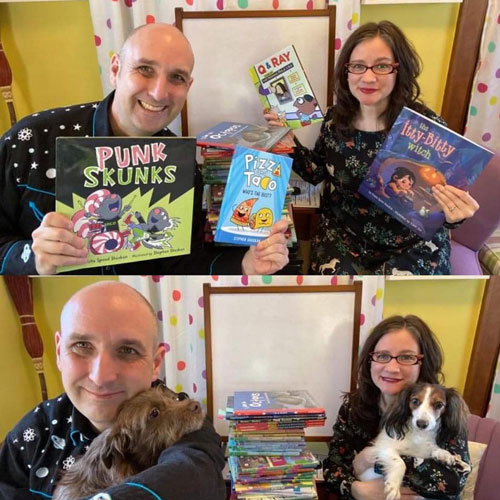
The best thing is being able to make something with my best friend and then share it together with audiences.”
How do you start your collaboration process?
We worked together on both the Q and Ray series and Punk Skunks right from the beginning. We brainstormed characters, which type of animals they would be, and a general plot. Once we had the basics, Trisha wrote the first draft and I sketched the characters.
How do you do things differently when you aren’t collaborating with another writer?
The Pizza and Taco series is quite a different process, even a different process from how I create my own picture books. I start with a basic plot for the story. For my first draft, I draw the entire book in my sketchbook in pencil with speech bubbles, very simply: Pizza is a triangle and Taco a semicircle. I’ve never actually had a typed manuscript for any of my Pizza and Taco books.
When I work on my own picture books, I typically start with a combination of several sketches and a typed manuscript. I rework the manuscript multiple times before I create a dummy book.
Along with Pizza and Taco: Super-Awesome Comic!, do you have other upcoming titles for readers to look forward to?
Pizza and Taco: Too Cool for School, the fourth book in the series, comes out in the summer of 2022. This one features a new character: BLT. I just signed contracts for books five and six. The fifth one, Pizza and Taco: Rock Out!, is already in the works.
How can educators, librarians, and readers get in touch with you?
You can contact me directly at stephenshaskan@gmail.com, find me on the web at stephenshaskan.com, friend me on Facebook at www.facebook.com/stephenshaskanchildrensbooks, follow me on Twitter at @SShaskan, and on Instagram at @stephenshaskan.






